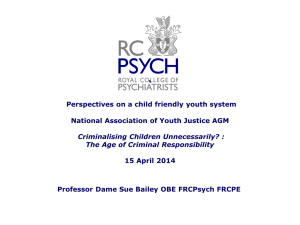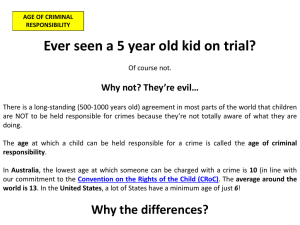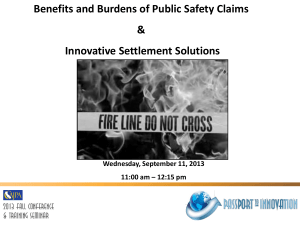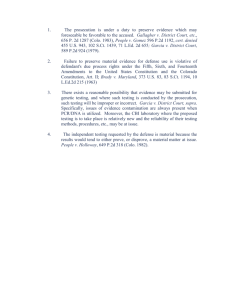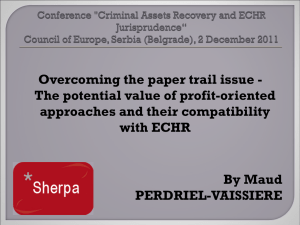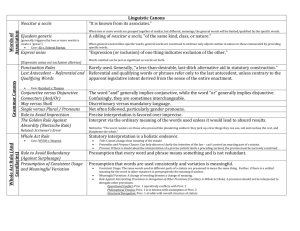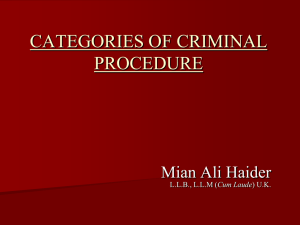Doli Incapax - Children`s Court Home
advertisement
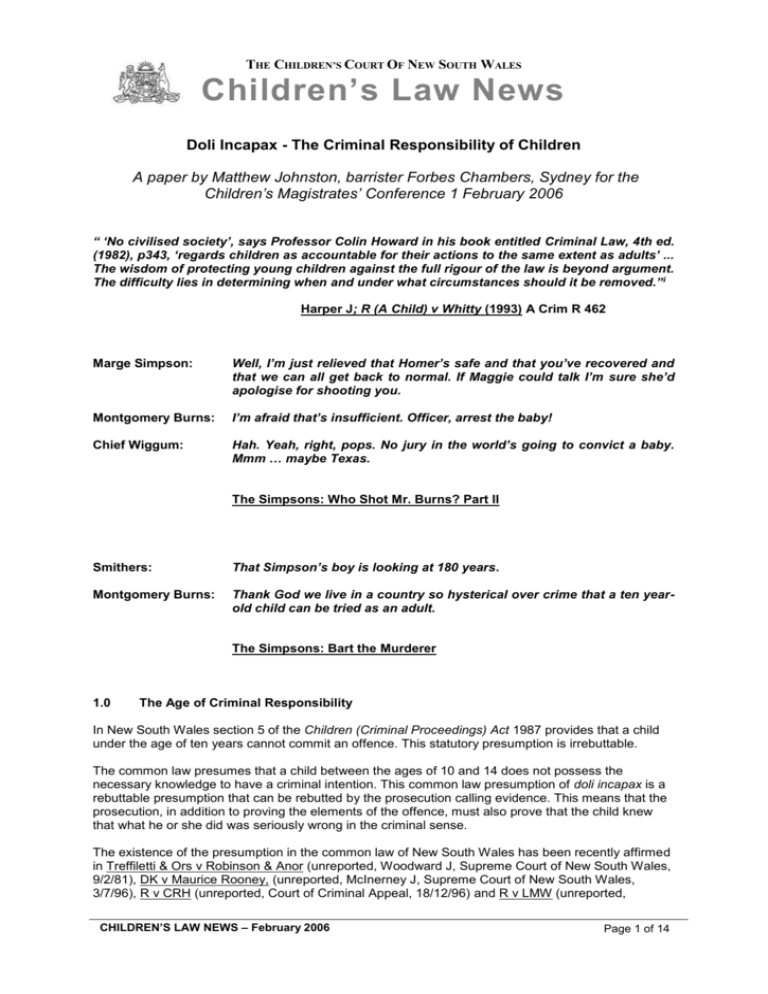
THE CHILDREN’S COURT OF NEW SOUTH WALES Children’s Law News Doli Incapax - The Criminal Responsibility of Children A paper by Matthew Johnston, barrister Forbes Chambers, Sydney for the Children’s Magistrates’ Conference 1 February 2006 “ ‘No civilised society’, says Professor Colin Howard in his book entitled Criminal Law, 4th ed. (1982), p343, ‘regards children as accountable for their actions to the same extent as adults’ ... The wisdom of protecting young children against the full rigour of the law is beyond argument. The difficulty lies in determining when and under what circumstances should it be removed.” i Harper J; R (A Child) v Whitty (1993) A Crim R 462 Marge Simpson: Well, I’m just relieved that Homer’s safe and that you’ve recovered and that we can all get back to normal. If Maggie could talk I’m sure she’d apologise for shooting you. Montgomery Burns: I’m afraid that’s insufficient. Officer, arrest the baby! Chief Wiggum: Hah. Yeah, right, pops. No jury in the world’s going to convict a baby. Mmm … maybe Texas. The Simpsons: Who Shot Mr. Burns? Part II Smithers: That Simpson’s boy is looking at 180 years. Montgomery Burns: Thank God we live in a country so hysterical over crime that a ten yearold child can be tried as an adult. The Simpsons: Bart the Murderer 1.0 The Age of Criminal Responsibility In New South Wales section 5 of the Children (Criminal Proceedings) Act 1987 provides that a child under the age of ten years cannot commit an offence. This statutory presumption is irrebuttable. The common law presumes that a child between the ages of 10 and 14 does not possess the necessary knowledge to have a criminal intention. This common law presumption of doli incapax is a rebuttable presumption that can be rebutted by the prosecution calling evidence. This means that the prosecution, in addition to proving the elements of the offence, must also prove that the child knew that what he or she did was seriously wrong in the criminal sense. The existence of the presumption in the common law of New South Wales has been recently affirmed in Treffiletti & Ors v Robinson & Anor (unreported, Woodward J, Supreme Court of New South Wales, 9/2/81), DK v Maurice Rooney, (unreported, McInerney J, Supreme Court of New South Wales, 3/7/96), R v CRH (unreported, Court of Criminal Appeal, 18/12/96) and R v LMW (unreported, CHILDREN’S LAW NEWS – February 2006 Page 1 of 14 THE CHILDREN’S COURT OF NEW SOUTH WALES Children’s Law News Supreme Court of New South Wales, Studdert J, 30/11/99). The defence and prosecution should consider doli incapax in all cases involving children under the age of 14. 2.0 The test for rebutting doli incapax The leading case in New South Wales on doli incapax is the decision of R v CRH (Unreported, NSW Court of Criminal Appeal, Smart, Hidden and Newman JJ, 18 December 1996). Newman J sets out the test for rebutting doli incapax and relies strongly on the House of Lords decision in C v DPP (1996) 1 AC 1 at 38: The test can be summarised as follows: The prosecution must rebut the presumption of doli incapax as an element of the prosecution case. The child knew the act was seriously wrong as opposed to naughty. The evidence relied upon by the prosecution must be strong and clear beyond all doubt or contradiction. The evidence to prove the accused’s guilty knowledge, as defined above, must not be the mere proof of doing the act charged, however, horrifying or obviously wrong the act may be. The older the child is the easier it will be for the prosecution to prove guilty knowledge. 2.1 The prosecution must rebut the presumption of doli incapax as an element of the prosecution case The presumption of doli incapax is not a defence; it is an element of the prosecution case. If the prosecution fails to call evidence to rebut the presumption there is no case to answer. If, at the conclusion of the prosecution case there is evidence that could satisfy a jury, the hearing or trial will proceed. In some cases the defence may elect to call evidence in the defence case. Ultimately, it is for the Magistrate or jury to determine at the end of the case whether this element has been established beyond a reasonable doubt. That is, it is for the Crown to establish to the criminal standard that the alleged offender had the capacity which the law requires. (See R v Vito Meola) (1999) NSWCCA 388). In C v DPP at 37E, Lord Lowry stated: “It is quite clear as the law that, as the law stands, the Crown must, as part of the Crown’s case, (his emphasis) show that a child defendant is doli incapax before the child can have a case to meet.” And earlier at 33G, “The presumption itself is not, and never has been completely logical; it provides a benevolent safeguard which evidence can remove. Very little evidence is needed but it must be adduced as part of the prosecution’s case, or else there will be no case to answer. Newman J, in R v CRH, approved of Lord Lowry’s comments adding at 11: “In short, it is my view that such Australian authority as exists is consistent with the law as expressed by Lord Lowry.” In R v CRH the NSW Court of Criminal Appeal held that the charge should have been taken from the jury, by the trial judge, once there was a finding that there was no conclusive evidence to rebut doli incapax. In R v LMW (unreported, Studdert J, Supreme Court of NSW, 30 November 1999) the defence made an application at the close of the prosecution case that the Crown had not rebutted the common law presumption of doli incapax. The application was rejected with the judge finding that ‘there is evidence CHILDREN’S LAW NEWS – February 2006 Page 2 of 14 THE CHILDREN’S COURT OF NEW SOUTH WALES Children’s Law News upon which the jury properly instructed could (his emphasis) conclude that the presumption has been rebutted.’ The issue of doli incapax was therefore left to the jury. The defence case commenced and evidence supporting the child was called on the issue of doli incapax. A copy of the decision is annexed to this paper. 2.2 The child knew the act was seriously wrong as opposed to a naughty In order to rebut the presumption of doli incapax the prosecution must prove that the child defendant did the act charged and that in doing that act he knew that it was a wrong act as distinct from naughty. “A long uncontradicted line of authority makes two propositions clear. The first is that the prosecution must prove that the child defendant did the act charged and that in doing that act he knew that it was a wrong act as distinct from an act of mere naughtiness or childish mischief.” Lord Lowry, C v DPP at 38C, and approved by the NSWCCA in R v CRH. However, there is often difficulty in determining whether the correct test is naughty, wrong or seriously wrong. Lord Lowry in C v DPP at 33D “I agree that the phrase ‘seriously wrong’ is conceptually obscure, and that view is confirmed by the rather loose treatment accorded to the doli incapax doctrine by the text books, but, when the phrase is contrasted with ‘merely naughty or mischievous’, I think its meaning is reasonably clear.” R v Runeckles (1984) The Times, 5 May 21) states that the prosecution must show that the act was ‘seriously wrong’ and not just something that would invite parental disapproval. In R v Gorrie (1918) 83 JP 136, Salter J directed the jury that the prosecution “… must satisfy the jury that when the boy did this he knew that he was doing what was wrong – not merely what was wrong but what was gravely wrong, seriously wrong.” 2.3 The evidence relied upon by the prosecution must be strong and clear beyond all doubt or contradiction The evidence the prosecution relies upon must be clear evidence that the defendant knew that his or her actions were wrong and not just naughty. If the evidence is ambiguous then it is not sufficient to rebut the presumption. Lord Lowry in C v DPP at 38C: “A long uncontradicted line of authority makes two propositions clear. The first is that the prosecution must prove that the child defendant did the act charged and that in doing that act he knew that it was a wrong act as distinct from an act of mere naughtiness or childish mischief. The criminal standard of proof applies. What is required has variously been expressed, as in Blackstone, ‘strong and clear beyond all doubt or contradiction’, or in Rex v Gorrie (1919) 83 JP 136, ‘very clear and complete evidence’ or in B v R (1958) 44 Cr App R1 at 3 per Lord Parker CJ, ‘It has often been put this way, that ... “guilty knowledge must be proved and the evidence to that effect must be clear and beyond all possibility of doubt’ “. (emphasis added) Again, in R v CRH the NSWCCA cites this entire passage with approval. CHILDREN’S LAW NEWS – February 2006 Page 3 of 14 THE CHILDREN’S COURT OF NEW SOUTH WALES Children’s Law News It is very important to read the entire passage of C v DPP in order to understand the test. Another paragraph in Lord Lowry’s decision is often, in the opinion of this writer, incorrectly cited as an alternative test. The paragraph of C v DPP in question is at 33: “The presumption itself is not, and never has been, completely logical; it provides a benevolent safeguard which evidence can remove. Very little evidence is needed but it must be adduced as part of the prosecution’s case, or else there will be no case to answer.” It has been suggested that this paragraph, particularly when read in isolation, is authority for ‘very little evidence’ being needed to rebut the presumption. However, it is submitted that this is incorrect. This section of Lord Lowry’s decision is in response to the Decision of Laws J in the Divisional Court. The test must be read with reference to his remarks at page 38C which discuss a long and uncontradicted line of authority. The test in summary reads, very little evidence (is needed to rebut the presumption) that is; clear beyond all doubt or contradiction, very clear and complete evidence’, and “guilty knowledge must be proved and the evidence to that effect must be clear and beyond all possibility of doubt’. This argument is also supported by the words of Lord Lowry at 38E, (see below) which confirm the Court’s desire to rely on the ‘emphatic tone’ of the directions in order to protect children. “No doubt the emphatic tone of some of the directions was due to the court’s anxiety to prevent merely naughty children from being convicted of crimes and in a sterner age protect them from the draconian consequences of conviction.” C v DPP and R v CRH are cases which turn on the requirement to call clear and cogent evidence. They also appear to suggest that if the evidence put forward to rebut doli incapax is equivocal or ambiguous then there is no evidence to rebut the presumption. In C v DPP the question of fact essentially posed is whether evidence of flight was suggestive of a guilty mind. Facts of C v DPP: The appellant was aged 12 and was seen by police officers using a crowbar to tamper with a motor cycle in a private driveway. Appellant ran away but was caught and arrested. The appellant was initially convicted. The Magistrate inferred from the fact that he ran away that he knew that what he had done was wrong. The House of Lords held that flight from scene can as easily follow a naughty action as a wicked one. In such circumstances the House of Lords were left with no option other than to find that the presumption had not been rebutted by the prosecution evidence. (at 39) “… Running away is usually equivocal … because flight from a scene can as easily follow a naughty action as a wicked one.” However, the House of Lords did go on to say (at 39) that there may be a few cases where running away would indicate guilty knowledge, where an act is either wrong or innocent and there is no room for mere naughtiness. “An example might be selling drugs at a street corner and fleeing at the sight of a policeman.” Facts in R v CRH: The defendant in that matter was 13 at the time of the alleged offence. The defendant is alleged to have woken the victim during the night in a room she was sharing with her sister. She felt a felt a tap on her shoulder and heard the appellant calling her name... somehow she ended up in the living room… the defendant is alleged to have forced her to suck his penis … the victim said she then heard a noise and the appellant pulled a blanket over her head. Soon after the victim said she heard her CHILDREN’S LAW NEWS – February 2006 Page 4 of 14 THE CHILDREN’S COURT OF NEW SOUTH WALES Children’s Law News elder sister’s voice and heard the appellant tell her sister that she, the complainant, was hiding from her. The Crown (at the bottom of page 5) relied on the ‘furtive’’ nature of the accused’s conduct; waking the complainant in the early hours of the morning, the carrying or encouraging the complainant to come with him into the lounge room, hiding the complainant’s head under the blanket and misleading the complainant’s sister when she was looking for her However, Newman J (at 9) was not satisfied that the actions of the appellant after the alleged commission of the sexual assault in question would be sufficient to satisfy the test stated by Lord Lowry. “I say this because the actions allegedly taken by the appellant are as consistent with naughty behaviour as wrong behaviour. On the criminal standard my view is that no prima facie case was made out.” The conviction was quashed and the verdict of acquittal entered. 2.4 The evidence to prove the accused’s guilty knowledge, as defined above, must not be the mere proof of doing the act charged, however, horrifying or obviously wrong the act may be The act itself cannot be used as evidence to rebut doli. The surrounding circumstances to the act can be used to rebut doli. Lord Lowry at 38: “The second clearly established proposition is that the evidence to prove the defendant’s guilty knowledge, as defined above, must not be the mere proof of the doing of the act charged, however, horrifying or obviously wrong that act may be. As Erle J said in Reg v Smith (Sydney) (1845) 1 Cox CC 260 ‘a guilty knowledge that he was doing wrong , must be proved by the evidence, and cannot be presumed from the mere commission of the act. You are to determine from a review of the evidence whether it satisfactorily proved that at the time he fired the rick (if you should be of the opinion he did fire it) he had a guilty knowledge that he was committing a crime.’” And also McInerney J in DK v Rooney & Anor (unreported, Supreme Court of NSW, 3/7/96): “On consideration of the authorities it is quite clear that in order to rebut the presumption of doli incapax it must be established by the prosecution beyond reasonable doubt not only that the child did the act in the circumstances which would involve adult criminal liability, but also that what he was doing was wrong. The knowledge is not to be presumed from the mere fact of the commission of the act, but it must be proved aliunde and may be proved inter alia by the circumstances attending the act, the manner in which it was done and the evidence as to the nature and disposition of the child concerned. The burden of proving that the child’s knowledge is wrong is on the prosecution, so at the conclusion of the evidence the prosecution must fail if the court is not satisfied beyond reasonable doubt of the child’s guilt.” And in Queensland in The Queen v Jay Michael Folling (Supreme Court of Queensland – Court of Appeal, 26/3/98) at 6: “I would therefore express my opinion that evidence of surrounding circumstances including conduct closely associated with the act constituting the offence may be considered for the purpose of proving the relevant capacity in relation to that offence … Such conduct may CHILDREN’S LAW NEWS – February 2006 Page 5 of 14 THE CHILDREN’S COURT OF NEW SOUTH WALES Children’s Law News include asserting a false alibi, rendering a victim incapable of identifying the accused or preventing a victim from summoning assistance during the commission of an offence. Although evidence of the accused’s age alone cannot rebut the presumption made by s29(2) of the Code, inferences capable of rebutting the presumption can be drawn from the accused’s age when considered together with evidence of the accused’s education or of the surrounding circumstances of the offence, or with observations of the accused’s speech and demeanour.” DK v Maurice Rooney is a useful case to understand this principle. The defendant was 12 years old in juvenile detention at Reiby. He was charged under s66C of the Crimes Act. (Sexual intercourse of a child between the ages of 10 and 16). The Magistrate was held to be wrong at law when he suggested that the act of sexual intercourse, without consent, was so ‘irretrievably wrong’ and so ‘intrinsically bad’ that the court could presume that the child should have known ... ‘that what he was doing was wrong.’ McInerney J held that the child’s acts constituting the elements of the offence are not evidence of knowledge that the act was wrong. The act itself cannot be relied upon to rebut doli incapax; however, evidence may be adduced by the prosecution regarding the surrounding circumstances attending the act, the manner in which it was done, and evidence as to the nature and disposition of the child. 2.5 The older the child the easier it will be for the prosecution to prove guilty knowledge The age of the child is very relevant in the prosecution’s attempts to rebut doli incapax. Section 5 provides an irrebuttable presumption up to 10. From 10 to 14 the common law presumption is rebuttable. The closer the child is to 10 the more difficult it is for the prosecution to rebut the presumption. The closer the child is to fourteen the easier it will be to rebut the presumption. The full Divisional Court in B v R (1960) 44 Cr App R 1 held at 3 “There is no doubt in the case of a child between the age of eight and fourteen that there is a presumption that the child is not in possession of that knowledge of which mens rea is an essential ingredient, and it is to be observed that, the lower the child is in the scale between eight and fourteen, the stronger the evidence necessary to rebut the presumption, because in the case of an eight year old it is conclusively presumed he is incapable of committing a crime.” Harper J in R (a Child) v Whitty was of the view that the closer the child is to the age of 14, the less strong the evidence needed to rebut the presumption. Also in DK v Rooney (unreported 3/7/96, McInerney J) at 8 “... to do so it (the prosecution) must make it appear to the tribunal that the child knew at the relevant time that what he or she was doing was more than merely naughty or mischievous. The standard of proof is the criminal standard. … it is also clear that the closer the child comes to that age (i.e. ten) the stronger must be the evidence to rebut the presumption. Stapleton v The Queen (1952) 86 CLR 358.” 3.0 The erroneous presumption of normality CHILDREN’S LAW NEWS – February 2006 Page 6 of 14 THE CHILDREN’S COURT OF NEW SOUTH WALES Children’s Law News In attempting to rebut the presumption of doli incapax it is often argued that a ‘normal’ child of ‘that’ age must have known that what it was doing was seriously wrong. Thomas Crofts in his article Rebutting the Presumption of Doli incapax (62 Journal of Criminal Law 185 at 188), refers to this as the ‘so-called presumption of normality’. Croft's argues that this ‘presumption of normality’ is erroneous. Firstly, the argument ignores the requirement that the prosecution is required to bring positive proof that the child in question has the requisite knowledge. It is not sufficient to simply argue that other children of this age would have known it was seriously wrong. The prosecution must prove beyond a reasonable doubt that ‘this’ child knew that ‘this’ offence was seriously wrong and not just naughty. Secondly, the presumption of normality misstates the law. The presumption of doli incapax presumes that a child between 10 and 14 does not have the capacity to differentiate between right and wrong. The presumption creates the requirement that the prosecution proves that a particular child has the capacity. To allow the prosecution to rebut the presumption without any positive proof would lead to a reversal of the burden of proof. If accepted, it would then fall upon the defence to prove that the child was below normal development. 4.0 Rebutting the presumption of Doli incapax The onus of rebutting doli incapax falls upon the prosecution. Evidence that can be used to rebut the presumption includes: 1. 2. 3. 4. 5. 6. 4.1 Statements/admissions made by the child Behaviour of the child before and after the act Prior criminal history Evidence of parents/ home background Evidence of teachers Evidence of psychologists/ psychiatrists Statements/admissions made by the child An admission made by a child will often be sufficient to rebut doli incapax. Thomas Crofts (at 187) argues: “It has been established that an important source of information for assessing a child’s appreciation of the seriousness of the act is what the child says when interviewed by the police. This type of evidence is preferable in as far as it refers directly to a child’s appreciation of the act itself and is not drawn from a general analysis of the behaviour and personality of the child.” The classic Australian case on point is the Victorian case of R (a child) v Whitty (1993) 66 A Crim R 462. In Whitty’s case a child was arrested for shoplifting and when interviewed by police regarding the offence used the words, ‘I stole’ (the goods). It was held that the use of these words was evidence of mischievous discretion. The child’s language was interpreted to indicate knowledge that the act of stealing was wrong, perhaps in contrast to the words ‘I took’. However, before an alleged admission could be used as evidence to rebut the presumption of doli incapax the usual questions relating to any alleged admission must be asked. Additionally, if the alleged admission was made, is it indicative of the child’s understanding at the time of the offence. (i) Is a child required to make admissions? CHILDREN’S LAW NEWS – February 2006 Page 7 of 14 THE CHILDREN’S COURT OF NEW SOUTH WALES Children’s Law News Despite the additional obligations placed on the prosecution in order to rebut doli incapax a child is still entitled to rely on his or her right to silence. A child under fourteen should be advised of the additional dangers of making a record of interview. If a child elects to make a record of interview the investigating police are likely to ask questions with the specific intention of rebutting doli incapax. The NSW Police Service ‘Code of Practice’ at page 33 reminds officers: “Remember, when interviewing children between 10 and 14 you need to obtain evidence they knew what they were doing was wrong (as opposed to mischievous or naughty).” (ii) Can otherwise inadmissible admissions be used to rebut doli incapax? A child should not be put into any worse position than an adult offender and is entitled to attempt to exclude otherwise inadmissible admissions. A quick checklist includes: (a) Are the admissions caught by s.13 of the Children (Criminal Proceedings) Act (1987)? (b) Did the child receive legal advice? See R v ME , R v LT and R v CE (Unreported, Supreme Court Common Law Division, 3 October 2002) (c) Are the admissions admissible under Part 3.4 of the Evidence Act? (d) Should the admission be excluded under s.90, s.135, s.137 or s.138? (e) Is the admission caught by s281 of the Criminal Procedure Act? (iii) Are the words attributed to the child ‘clear beyond all doubt or contradiction’? The alleged admissions must show that the child understood that his actions were seriously wrong and not just naughty. If the admissions are equivocal, or ambiguous, then it can be argued that the prosecution has not successfully rebutted the presumption. It has been suggested in IPH v. Chief Constable of South Wales it was suggested that the most appropriate way to determine the doli incapax issue is for investigating police to ask the child ‘did you appreciate that what you did was seriously wrong?’ In the absence of such a direct question, the evidence will require the Court to interpret what was the understanding of the child. Facts of IPH v. Chief Constable of South Wales [1987] Crim LR 42. An 11-year-old boy was convicted of criminal damage to a van. The van’s windows were smashed, the paintwork was scratched and the van was pushed into a pole. The child was interviewed by police. During the interview the child said, “Yeah, I knew I would damage the truck by pushing it into the pole”. On appeal the Divisional Court said that the admission proved that the child knew that damage would result from the action. The admission did not prove knowledge that the action was seriously wrong as opposed to mischievous or naughty. (iv) Do the admissions indicate the child’s understanding at the time of the alleged offence? The child’s intention must be assessed at the time of committing the offence. Any statements given by a child after the offence may have been tainted or affected by the process. It is arguable that since being arrested, taken to a police station and placed in a dock the child has come to an appreciation that he or she has done something wrong. This understanding may not have been consistent with the child’s state of mind at the time of the alleged offence. 4.2 Behaviour of the child before and after the act CHILDREN’S LAW NEWS – February 2006 Page 8 of 14 THE CHILDREN’S COURT OF NEW SOUTH WALES Children’s Law News While evidence of the act itself, no matter how horrifying, cannot be relied upon, evidence of the child’s behaviour before, after and going to the surrounding circumstances of the offence may be admissible. See The Queen v. Folling (QLD CCA, Unreported, 19 May 1998) A 14 year old boy who during a home invasion blindfolds the victim and warns the victim not to move for five minutes after he leaves and later gives the police a false alibi Folling who was, 14 years 9 months1, entered the victim’s house with another young person while the victim was asleep. Folling woke the victim, assaulted him, demanded drugs from him, bound and blindfolded him and warned him not to move for five minutes after he left. One of the offenders cut the telephone cord. The Queensland CCA held that conduct, including conduct closely associated with the act, could be considered on the issue of doli incapax. Such conduct may include giving a false alibi, rendering a victim incapable of identifying the accused or preventing the victim from summoning assistance during the commission of an offence.2 For the Crown to rely on behaviour the Crown must be able to show that the actions of the child effectively amount to an admission that the child knew that the act was seriously wrong. In LMS (1996) 2 Cr App R 50 at 54, the child’s mischievous discretion was seen in the fact that he persistently lied, pretended to find the body of his cousin (of whom he was accused of attempted murder) called the police and pretended that he saw the assailants run away. The attempts to conceal his actions were held to show that he knew that he had done something seriously wrong. However behaviour, such as running away, in combination with an admission may well be sufficient to rebut the presumption: T v. DPP [1997] Crim LR 127: T, an 11-year-old boy, stole sandwiches from a store. When T realised he had been spotted by a security guard he threw the sandwiches down and ran away. When interviewed in the presence of his mother T admitted that he had no money and knew the sandwiches were stolen as he walked out of the shop. On appeal the court said running away in combination with the admission was sufficient to rebut the presumption. JM (a minor) v. Runeckles (1984) 79 Cr App R 255: JM, a 13 year old girl stabbed another girl with a broken milk bottle. JM went to the victim’s home, knocked on the door and threatened to break in. When the victim opened the door JM stabbed her and ran away. Following the incident JM was seen by police who pursued her. She ran away from them but was caught. JM told police that she thought they were looking for her. The evidence of flight, together with her statement to the police was enough to rebut the presumption. Flight is a good example of behaviour that can be equivocal – children run away because they think they are going to get into trouble – even when they are not sure what they are getting in trouble for. (C v DPP – discussed earlier) The latest case on this point is R v ALH [2003] VSCA 129 (4 September 2003). This case dealt with whether acts constituting the offences and applicant's age may be sufficient on their own to discharge onus. In this case, the child offender and victim were siblings. The child offender was charged with two counts of indecent assault and two counts of sexual assault/rape occurring on four different dates. The age range was from 13 and 8 months to 12 days before his fourteenth birthday. All four incidents occurred whilst the child offender and his sister were home alone. Their mother and mother’s partner were at alcoholics anonymous. The victim was 12 years old at the time, described isolated and The Queensland Criminal Code provides under s.29 (2) that “a person under the age of 15 years is not criminally responsible for an act or omission, unless it is proved that at the time of doing the act or making the omission the person had the capacity to know that the person ought not to do the act or make the omission.” 1 2 See also H and Others v DPP [1997] Crim LR 127 May 2, 1996, Queen’s Bench Divisional Court. CHILDREN’S LAW NEWS – February 2006 Page 9 of 14 THE CHILDREN’S COURT OF NEW SOUTH WALES Children’s Law News vulnerable and cried throughout the incidents. The child offender had no prior record. The court held that at [74]: “Acts may be so serious, harmful or wrong as properly to establish requisite knowledge in the child; others may be less obviously serious, harmful or wrong, or may be equivocal, or may be insufficient. I consider that the correct position is that proof of the acts themselves may prove requisite knowledge if those acts establish beyond reasonable doubt that the child knew that the act or acts themselves were seriously wrong.” Arguably, ALH has not followed the C v. Director of Public Prosecutions [1996] A.C. 1 on this point, and extends the law to consider the seriousness of the acts themselves rather than the surrounding circumstances. In New South Wales, there has been no specific decision on this issue, though it is open to argue that CRH is still authority for what Lord Lowry described as the second, long and uncontradicted line of authority, that ‘evidence to prove the defendant’s guilty knowledge, as defined above, must not be the mere proof of doing the act charged, however, horrifying or obviously wrong that act may be.’ 4.3 Prior Criminal History In some circumstances the prior criminal history will be admissible to rebut doli incapax. The prosecution will argue that the record is evidence that the child has been in contact with the criminal justice system and has been told by the police or courts that those types of actions are wrong. Evidence of prior cautions or youth justice conferences may also be admissible. However, the mere presence of a criminal history is not conclusive evidence. A child who has a criminal history is not precluded from raising doli incapax as an issue at a hearing for a later offence. A prior charge of assault does not necessarily mean that a child will have an understanding of the offence of Goods in Custody. The elements of the offence and the complexity of the charge should also be carefully considered. In circumstances where the prosecution relies on complicity, common purpose, or omissions, there may be scope to argue the child was not aware that he or she was committing an offence. The question should also be raised as to whether it is appropriate for a child to have his or her criminal history raised in court. Such a step would be considered highly prejudicial to an adult defendant. Why should a child be afforded less protection than an adult should? In C v. DPP at 34, Lord Lowry said that the governing principle on the admissibility of prior convictions is that a child offender should not be in any worse position than an adult offender should. However, it was conceded at page 33H, that ‘the need for the prosecutor to rebut the presumption may give rise to injustice where the rebuttal involves proving previous convictions.’ Newman J in Ivers v Griffiths (NSW Supreme Court, 22 May 19998) adopted Lord Lowry’s view in C v. DPP and said that where the primary facts were not in issue, and the record went only to the doli incapax issue, the prior criminal history could be tendered. There is authority to suggest that in some circumstances evidence of a prior record is so compelling on the issue of doli incapax that it is admissible even where the primary facts are in issue. The Full Court of the Supreme Court of South Australia held in The Queen v. M (1977) 16 SASR 589 that evidence of past convictions were admissible. M, who was 12, murdered a younger boy by hitting him on the head with a brick. M then concealed the body and misled searchers who were looking for the boy. M was questioned by police about this matter and other matters including assaults on other children, stealing, arson and breaking and entering. M told police that he knew that in committing those prior offences he was doing seriously wrong acts. CHILDREN’S LAW NEWS – February 2006 Page 10 of 14 THE CHILDREN’S COURT OF NEW SOUTH WALES Children’s Law News Dr Bray CJ said at 594: “The rule excluding evidence of past misbehaviour yields when that evidence is relevant to prove one or more of the elements of the crime in issue, and I think this was so relevant, or rather, I think that evidence of his admissions during the course of his interrogations about his past crimes was so relevant, and that evidence could not be given without disclosing the commission of other crimes. Nor do I think that her Honour was bound to exclude the evidence in the exercise of her discretion. It was, I think, highly probative that the appellant was doli capax, even if it was also highly prejudicial.” The Queensland CCA took a similar approach in R v. Folling. In Folling the Crown sought to adduce evidence of prior interviews with police in relation to charges of housebreaking, trespassing on school grounds, willful damage and obstructing police. In the interviews Folling had admitted that he was aware that his actions were wrong. The evidence did not amount to similar fact evidence. The evidence was excluded at trial and the Crown appealed. The Queensland CCA held that even where the evidence is prejudicial where it is highly probative of the defendant’s state of knowledge it is admissible to rebut the presumption. See also G v. DPP (Unreported, Queen’s Bench Division, 14 October 1997) where evidence of a prior allegation of indecent assault, for which the child was punished, was admitted against a 12 year old charged with indecent assault to rebut the presumption. The key consideration on this question is the nature of the earlier convictions. Where the prior record shows matters of similar offences and there is evidence of admissions made by the child indicating that he or she knew the act to be wrong then the prior record may be admissible. Where the prior matters are of a completely different nature it may be possible to argue that the evidence is irrelevant, or that the prejudicial effect outweighs the probative value. 4.4 Evidence of parents/home background A common method of rebutting the presumption used to be for the prosecution to call evidence from parents, guardians or family friends that can attest to the fact that the child knew that committing the alleged act was seriously wrong as opposed to naughty. The parents, who had come to court in support of the child, were called without notice to give evidence and when questioned were likely to confirm, ‘that they have brought the child up well’, ‘taught the child the difference between right and wrong’, and ‘made sure the child is aware of the law’. The ‘ambush’ element of this tactic has now been avoided with the introduction of section 66 of the Justices Act (now section 183 Criminal Procedure Act). If a statement has not been served before the hearing objection can be made to the parents being called to give evidence. Additionally, section 18 of the Evidence Act provides that a “parent” may object to giving evidence against the child as a witness for the prosecution. The witness must take the objection and the Court must satisfy itself that the person is aware of their right to object to giving evidence. If the parent objects they must not be required to give evidence if the Court finds that: S.18(5)(a) (b) There is a likelihood that harm would or might be caused (whether directly or indirectly) to the person and the defendant, if the person gives evidence; and The nature and extent of that harm outweighs the desirability of having the evidence given. Parent and child are widely defined in the Evidence Act and include adoptive parents, ex-nuptial parents and a person with whom the child is living as if the child were a member of the family. CHILDREN’S LAW NEWS – February 2006 Page 11 of 14 THE CHILDREN’S COURT OF NEW SOUTH WALES Children’s Law News Other family members or family friends may be called. Section 18 does not extend to such situations. In cases such as CRH, where the accused and the victim were cousins, the Crown perhaps could have called the accused’s aunt or uncle on the issue. General evidence of the child’s home background can be used to rebut the presumption. In B v. R [1958] 44 Cr App R 1: a 9-year-old boy was convicted of BES. The only evidence with respect to doli incapax was that the boy came from a respectable family and was properly brought up. The Court held that the evidence of his upbringing was sufficient evidence to rebut the presumption. One of the criticisms of this approach is that a child who comes from a very poor background with limited opportunity for education, both social and formal, and with poor parental examples is more likely to avoid prosecution than a child that was brought up in a good home. Though others would argue this is the exact purpose of the presumption. Each case must be approached from the subjective circumstances of the child and not the presumed normal understanding of a child of a particular age. A child who has a learning difficulty is not equal to that of a normal child. There may be cultural considerations may also be important. For example, a child that comes from a community where there is less emphasis placed on ownership of objects may not understand that taking a bike from another child is seriously wrong. 4.5 Evidence of teachers In C v. DPP Lord Lowry suggests another way to rebut doli incapax is for the prosecution to obtain evidence from a teacher who knows the child well. It is argued that teachers will have been in close contact with the child and may be in a position to provide information that assists in understanding the child’s mental and moral development. It is important to look closely at any statements from teachers. There is a world of difference between school rules and criminal liability. While a child may have an understanding of school rules is it appropriate to extrapolate this understanding to the wider world. Does an understanding to stay within bounds at school assist in determining whether a child understands that it is seriously wrong to sexually assault another child? In Graham v DPP [1997] EWHC Admin 869 (1997), the court also held that a teacher’s statement relating to past disciplinary action could be admitted. It is a case where the appellant and victim were 12 years old and attended the same high school. The appellant had sexually abused the victim after an argument. The Crown sought to tender a statement from a Mr. Hiscock, a head teacher. Mr. Hiscock gave evidence that the appellant had been lectured and suspended from school for a similar matter where he pulled a girl’s underwear off in a classroom. The question in the appeal was whether the teacher’s statement was admissible. The appellant denied the earlier incident and his counsel argued that the statement would have the effect of allowing a prior conviction be used to prove a new offence. The respondent argued that the statement was relevant to the issue of doli incapax and that it would have been made clear to the child on this occasion serious nature of his conduct. Issues to canvass when looking at teacher’s statement and reports 1. Look at whether the evidence goes to the specific nature of the charge? 2. What is the relationship between the teacher/Principal and the child? 3. Is this a matter that has been discussed in class at any time? 4. What was the nature of that discussion? 5. Was the child present for that discussion? 6. Was the child disciplined for a similar offence? 7. What was the nature of the disciplinary action? There is also an issue as to the potential damage to relationship between child and teacher if a teacher is compelled to give evidence against a child however, the provisions of section 18 of the Evidence Act do not extend to protecting this relationship. CHILDREN’S LAW NEWS – February 2006 Page 12 of 14 THE CHILDREN’S COURT OF NEW SOUTH WALES Children’s Law News 4.6 Evidence of psychologists and psychiatrists Evidence from psychologists and psychiatrists may assist the court on the issue of doli incapax. In R v LMW both prosecution and defence called evidence. There is case law from the United Kingdom that suggests that evidence from psychologists would not be accepted. “It is for the court to decide as a fact whether what the defendant did or said before or after the incident indicated his state of mind at the time of the offence and his appreciation of the seriousness of what he did. That essential function must not be usurped by or delegated to psychiatrists or others: T v. DPP, L v. DPP, H v. DPP [1997] Crim LR 127.” However, that position is disputed by Crofts in his article “Rebutting Doli incapax”; The suggestion that obtaining evidence from these sources would undermine the power of the court, is to say the least tenuous. People giving such evidence would not prejudge the issue, because in all cases where expert witnesses are called, their function is merely to give advice and information and assist the courts in its direction. As such it is for the court to ensure that it decides independently on the basis of the evidence laid before it.” . The defendant obviously has the right to silence and cannot be forced to see a psychologist or psychiatrist. However, if the child had a pre-existing relationship with a psychologist or psychiatrist it may be that a report is requested by the defence. Issues of confidential relationship privilege (s126A Evidence Act) may arise in these circumstances. Alternately, the defence or prosecution may seek to obtain an assessment and report. Such an approach requires the cooperation of the accused. However, practitioners should be aware that if a report is obtained by the defence the prosecution is likely to make a request that the child also attend upon a psychiatrist or psychologist commissioned by the prosecution. Objective testing by psychologists may give a strong indication of the child’s mental and cognitive abilities at the time of testing and by extrapolation of the likely levels at the time of the alleged offence. Subjective interpretation of even standard tests may lead to inconclusive, irrelevant and potentially prejudicial material being presented. Inevitably any assessment is conducted after the alleged offence and after the child has been charged. There is always a real risk than any subjective assessment is contaminated by the charging and court process and precludes any useful insight to the mind of the child at the time of the offence. The decision of Studdert J, R v LMW (unreported, Supreme Court of NSW, 25 November 1999) gives an interesting insight to the need to balance the probative value of the reports with any prejudicial material. Concluding observations The presumption of doli incapax was abolished by statute with the commencement of the Crime and Disorder Act 1998 (UK) on 30 September 1998. The Criminal Law Review Division of NSW conducted a review of the law on the age of criminal responsibility in January 2000 following the trial of LMW. At the time of re-writing this paper in January 2006 the common law in New South Wales remains unchanged, though opinions on the suitability of the presumption of doli incapax still vary dramatically, even outside the editorial pages of the Daily Telegraph. Inevitably every time a young offender is charged with a serious offence the debate is reignited. CHILDREN’S LAW NEWS – February 2006 Page 13 of 14 THE CHILDREN’S COURT OF NEW SOUTH WALES Children’s Law News The former NSW Senior Children’s Court Magistrate, Steve Scarlett, was of the opinion that ‘in a world or video cassette recorders and the internet, that many 12 and 13 year olds are a lot more sophisticated these days than they were 30 years ago, and that the legislature should think seriously about drawing a younger line, say 12.’ Whereas Doctor Brent Waters when interviewed after the trial of LMW stated: Doli incapax enshrines the fact that there is a transition between taking an exclusive child’s rights focus and the development of personal autonomy and responsibility. Without doubt it is a difficult problem because maturity varies from individual to individual and is shaped by social forces that effect when these transitions occur. But the problem of transition is well recognized in this principle. Many people would argue that childhood is being shrunk through exposure to movies, video games and so on, but I don’t think popular entertainment has any impact on the sort of act this boy carried out – pushing someone in a river. In my opinion all the social evidence today indicates that childhood is being extended in an number of ways. If you go back 400 years when the average life span was perhaps 35 years, people had their families almost in their teenage years. Society at the time required children to assume all sorts of responsibilities earlier in their lives. Things are totally different today. More and more children are being retained for a longer period in a dependant sort of status. The common law presumption remains controversial and commentators will continue to differ on their opinion as to the merits of the current system. However, the words of Harper J., of the Supreme Court in Victoria still ring true; …‘The wisdom of protecting children from the full rigour of the law is beyond argument. The difficulty lies in determining when and under what circumstances protection should be removed.’ © Copyright 2006 Crown Copyright All material is reproduced by permission of the Crown but does not purport to be the official or authorised version. Downloading, copying or printing of materials in this database for personal use, or on behalf of another person, is permitted. Downloading, copying or printing of material from this database for the purpose of reproduction or publication (in whole or in part) for a fee is not permitted without express authorisation. CHILDREN’S LAW NEWS – February 2006 Page 14 of 14
